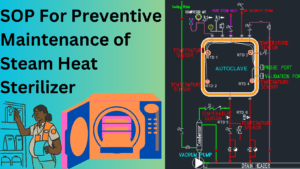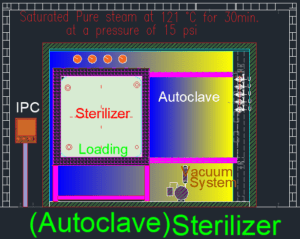The purpose of this Standard Operating Procedure SOP For Preventive Maintenance of Steam Heat Sterilizer is to outline the guidelines and procedures for the preventive maintenance of the Steam Heat Sterilizer to ensure its optimal performance, reliability, and safety. Regular maintenance of the sterilizer is essential to maintain its efficacy in sterilizing equipment and materials.
SOP For Preventive Maintenance of Steam Heat Sterilizer
- OBJECTIVE:
- To lay down the Procedure for Preventive Maintenance of the Steam heat sterilizer installed in the plant.
- SCOPE:
- This SOP is applicable to the Preventive Maintenance of the Steam Heat Sterilizer installed in Plant.
- RESPONSIBILITY:
- The technician/ Operator shall be responsible for the proper execution of preventive maintenance as per SOP.
- Engineering – Head shall be responsible for reviewing the SOP and for ensuring proper execution of preventive maintenance.
- ACCOUNTABILITY:
- Engineering – Head shall be accountable for proper implementation of the SOP.
- DEFINITIONS:
- Nil
- PROCEDURE:
- Preventive maintenance shall be executed as per SOP No.: SOP/EN/XXX – Execution of Preventive Maintenance.
- Ensure that the spare parts are available at the time of preventive maintenance.
Preventive Maintenance of Steam Heat Sterilizer– Mechanical
- Checking and Lubrication of Door Gaskets
- Check the condition of Non-sterile and sterile side door gaskets for any damage OR insufficient lubrication. If found damaged replace the gasket by following procedure.
- Remove the door gasket from the groove.
- Remove the spring from the groove.
- Clean the Groove, Spring & Gasket with Isopropyl Alcohol (IPA) thoroughly.
- Apply food-grade lubricant in the Groove.
- Put the spring in the Groove.
- Apply food-grade lubricant on the Gasket.
- Put the Gasket in the Groove by pushing it slowly.
- Conduct chamber vacuum leak test.
- Checking shall be done Monthly.
- Check the chamber safety valve.
- Check the chamber safety valve by following the procedure:
- Close both doors.
- Switch on the Chamber steam in the valve, and let the chamber pressure increase above the pressure set on the safety valve.
- Steam should start coming from the safety valve outlet at the set pressure.
- If the safety valve does not operate at set pressure then re-set it at required pressure.
- Check the safety valve as per the new setting. If the safety valve doesn’t operate, then replace it with a new one.
- Checking shall be done Quarterly.
- Check the Jacket safety valve.
- Switch on the Jacket steam in valve, let the Jacket pressure increase above pressure set on safety valve.
- Steam should start coming from the safety valve outlet at set pressure.
- If the safety valve does not operate at set pressure then re-set it at required pressure.
- Check the safety valve as per new setting. If the safety valve doesn’t operate, then replace it with a new one.
- Insert the spring and then gasket in the gasket groove.
- Checking shall be done Quarterly.
- Checking of Vacuum Pump
- Check the rubber spider of the coupling for any damage, replace if required.
- Check the alignment of motor and pump. Rectify / adjust it if required.
- Check the vacuum pump for water leakages, if leakages are observed rectify the same.
- Check Oil level of FRL.
- Checking shall be quarterly.
- Checking of leakages
- Check for any leakage of water from pipe fittings (Valves, strainer NRV etc.) and connectors.
- If any leakage is observed, check O-rings, gaskets, and diaphragm and replace if found damaged OR worn out.
- Check all the clamps and tighten them if required.
- Check the leakages from pumps at its inlet and outlet port, if any leakage is observed arrest the same by providing new gasket and tightening the line connectors.
- Checking shall be done Quarterly.
- Checking of pneumatic tubes and connectors
- Check the pneumatic tubes and connectors for any damage/leakage. There should not be any damage/leakage in the tubes and connectors.
- Physically check the tubes for any damage/leak is observed, replace the tube/connector.
- Checking shall be done Quarterly.
- Checking / cleaning of steam traps.
- Open the tri-clover clamp and remove the steam trap from the drain line of the chamber.
- Open the cover nut and remove the float ball out and clean it with potable water.
- Reassemble the steam trap.
- Checking shall be done Quarterly.
- Check the printer.
- Check the recording instrument for proper prints. Replace the ink cartridge if necessary.
- Frequency of checking shall be after every three months.
- Checking of vacuum pump bearing.
- Check the vacuum pump smoothly running, if found any abnormal noise from the bearing housing side, rectify the same.
- Remove the end plate of the vacuum pump.
- Open the vacuum pump housing. Take out the impeller shaft from the bearing housings.
- Replace the inner race of bearing on the shaft.
- Replace the outer race of the bearing. Fill up all-purpose extreme pressure, high-temperature grease in the bearing housing.
- Fix the end plates and tighten them.
- Checking frequency of bearing is Quarterly.
- Replace the vacuum break filter cartridge & Compressed/ Process air filter cartridge once in a year.
Fault and Remedial action in Preventive Maintenance of Steam Heat Sterilizer
| FAULT | REMEDY |
| Steam Pressure inside the jacket does not rise up to 1.2 kg/cm2 (g) or 2.2 kg/cm2 (g) | Check steam trap, Check incoming steam utility |
| The control “ON” indication does not glow | Check the incoming electric supply. Check Mains isolator. Check Fuse as per ‘Electric Wiring Diagram’. |
| Door not closing (Movement Only) | Check the incoming electric supply. Check the Mains isolator. Check Fuse as per ‘Electric Wiring Diagram’. |
| Gasket not pressurizing | Check the Compressed air supply. Ensure Pressure is above-specified limits. Check whether limit switch LS1/LS2 is activated. Check the solenoid valve. Check the Pressure Setting on the Pressure switch. Clean & Lubricate the Gasket Groove. Check the gasket for any damages. |
| Door Gasket not retracting | Check the compressed Air Supply. Check the solenoid Valve. Check the setting on the Vacuum switch. Clean & Lubricate Gasket Groove as detailed in. Check the gasket for any damages. |
| Door not opening (Movement only) | Check the Compressed air supply. Ensure Pressure is above-specified limits. Check solenoid valves. Check Pneumatic Cylinder. |
| Unloading / Loading door close PB pressed gasket comes out | Check the door close Limit Switch whether it has got stuck by pressing it 2 to 3 times. |
| Vacuum not being created in the chamber. | Check the pneumatic tubing. Check the pneumatic pressure. Check whether the cylinder stroke passes Through the hole of the locking plate welded on door bottom side 4. Check for any leakage in door cylinder |
| Door bangs on closing or opening end | Adjust the blue color flow control valve located at the bottom/door opening end of door operating cylinder. |
| Door not closing properly gets stuck in between | Check the incoming compressed air pressure (range should be 6 to 7 kg/cm2 (g). Check the door component alignments. Check the door surface. Check for proper retraction of the gasket. |
| Door movement is not smooth | Check whether all pre-conditions are fulfilledCheck input status as per process I/O DiagramCheck whether emergency stop switch is actuated. |
| The door locking cylinder not releasing | Check whether all pre-conditions are fulfilledCheck input status as per process I/O DiagramCheck whether the emergency stop switch is actuated. |
| Operator Interface does not indicate temperature or indicates it as “Zero” or very high. | Check the wiring connections. Check RTDCheck D.C source output. Check temperature transmitter output. If any of the component is faulty replace the same. |
| The process not getting aborted. | Check the wiring connections. Check Pressure transmitter output. Check D.C source output. If the component is faulty replace the same. |
| The process does not start | Check abort Key switch contacts. Check the related wiring. |
| Vacuum not being created in chamber. | Sterilization Temperature not achieved even after Pressure has attained a pre-determined value in the chamber. |
| Temp / Pressure not building up in chamber. | Check the condensate Line for any blockages. Check the setting of the condensate needle wall. Check the incoming steam pressure. It should not go above the required pressure. |
| The operator interface does not indicate pressure. | Check the condensate Line for any blockages. 2. Check the setting of condensate needle wall. |
| The time for the Vacuum break is too long. | Temperature Overshoot in the chamber. |
| Check the interlinking cable. Check for proper earthing | Check the closing of the door & pressurization of the gasket. Check the working conditions of indication. Check the gasket pressurization pressure switch operation |
| Pre conditions not fulfilled. | Check the closing of door & pressurization of the gasket. Check the working conditions of indication, Check the gasket pressurization pressure switch operation. |
| The operator interface is blanked off | Pre-conditions not fulfilled. |
| Pre-conditions not fulfilled. | Check interlinking cable. Check for proper earthing |
| Indication (s) illuminated (Dim) when not required. | Check phase & neutral contact for reverse connection. |
| If any valve is not operating | Check the related fuse as per the wiring diagram. Check for jamming of valve check nut. |
You may also read about Good Laboratory Practices (GLP)



